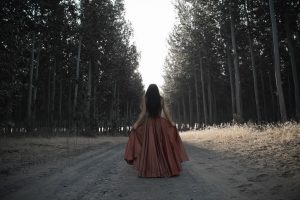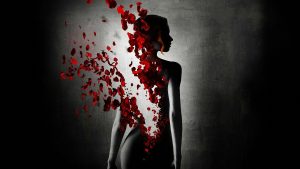“As my eyes adjust to the dark, the lights coalesce into silhouettes, and I realize the room is full of women. Women like the one in the viral video, see-through and glowing faintly, like afterthoughts. They drift and mill and occasionally look down at their bodies.”
The fantastical qualities exhibited in a high quantity of Machado’s works presented within this collection of short stories seems to be laboriously immersed and heavily saturated in some kind of element of enchantment – a loosely based legend or folklore. Her narratives, all spoken from the perspective of a woman, are imbued with little snippets of allusions towards fairytales that delve deeper than simple fantastical characteristics. There’s a dark property; a chilling aspect, and “Real Women have Bodies” is no exception.
 In this particular story, we are greeted with elements parallel to that of both European-esque folk and fairy tales. More specifically, the integration of magical dresses into the properties of fanciful and illusory illustrated internally bring to mind the infamous tale of “Cinderella.” This prominence; this focus on the gowns promotes and encourages comparisons to relating stories, stories oftentimes told to young girls. Simultaneously, the concluding dissipation and destruction of the female body draws parallels to “The Little Mermaid.” However, the desolation and sorrow encompassed in this particular story and –oftentimes lacking in children’s fairy tales– encourage a more mature audience, an audience no longer innocent, naive, and sheltered from the obscurities of being a woman in society, who are attempting and ultimately failing to either meet or discourage these set standards. There’s a disintegration, a fading of sorts, as women grow and abandon their youths to discover that the real world is nothing like glass slippers, magical wands, and happy endings.
In this particular story, we are greeted with elements parallel to that of both European-esque folk and fairy tales. More specifically, the integration of magical dresses into the properties of fanciful and illusory illustrated internally bring to mind the infamous tale of “Cinderella.” This prominence; this focus on the gowns promotes and encourages comparisons to relating stories, stories oftentimes told to young girls. Simultaneously, the concluding dissipation and destruction of the female body draws parallels to “The Little Mermaid.” However, the desolation and sorrow encompassed in this particular story and –oftentimes lacking in children’s fairy tales– encourage a more mature audience, an audience no longer innocent, naive, and sheltered from the obscurities of being a woman in society, who are attempting and ultimately failing to either meet or discourage these set standards. There’s a disintegration, a fading of sorts, as women grow and abandon their youths to discover that the real world is nothing like glass slippers, magical wands, and happy endings.
This reworking of an aspect so familiar to a female audience is almost necessary; to be reminded that we have almost no control over the worth of our bodies, oftentimes measured by outside forces, forces we cannot control.
 Yet the folktale aspect still stands true. The general type of story, where a man or prince meets a woman not entirely whole; not entirely human, and they embark on a romantic association that is sometimes one-sided (as perceived in the selkie stories), are widespread and sprinkled within stories still told today. Always in the end, the woman finds means of escaping and is able to return to her own; return to the sense of womanhood represented by the dresses. These specifically obscure fairytales with darker attributions and themes come to reflect a sense of cultural entrapment. Brides married off too young, women stolen from their homes, etc. This apprehension conveys the ideals of the control that men have, the capacity to capture, to misunderstand, and to rip away at the seams of womanhood until there is nothing left; until they fade away into nonexistence.
Yet the folktale aspect still stands true. The general type of story, where a man or prince meets a woman not entirely whole; not entirely human, and they embark on a romantic association that is sometimes one-sided (as perceived in the selkie stories), are widespread and sprinkled within stories still told today. Always in the end, the woman finds means of escaping and is able to return to her own; return to the sense of womanhood represented by the dresses. These specifically obscure fairytales with darker attributions and themes come to reflect a sense of cultural entrapment. Brides married off too young, women stolen from their homes, etc. This apprehension conveys the ideals of the control that men have, the capacity to capture, to misunderstand, and to rip away at the seams of womanhood until there is nothing left; until they fade away into nonexistence.
“From the blackness of the floor, I see them all, faintly luminous, moving about in their husks. But they remain. They don’t move, they never move.”